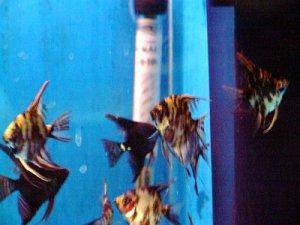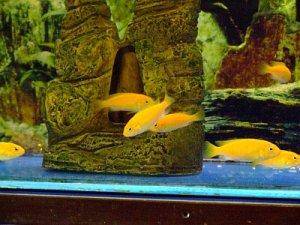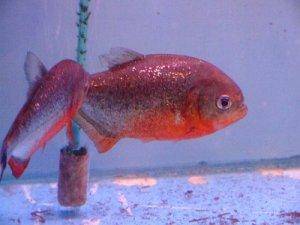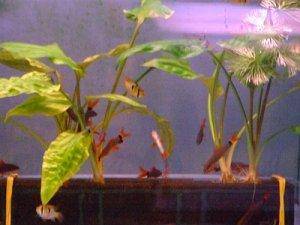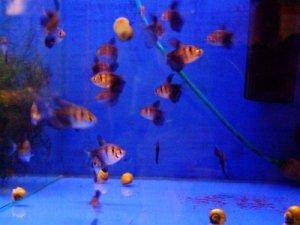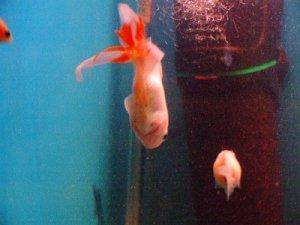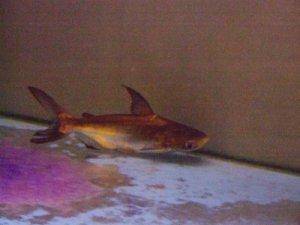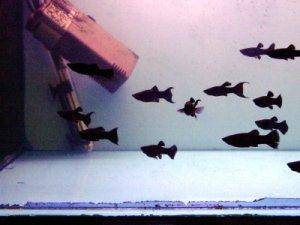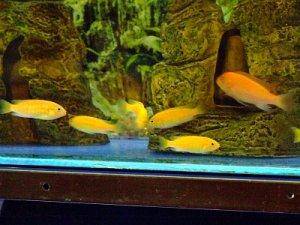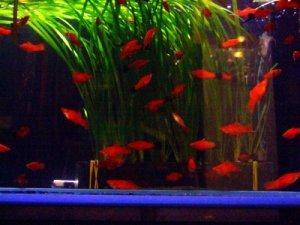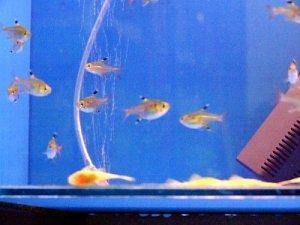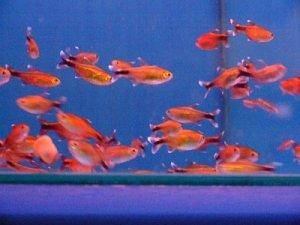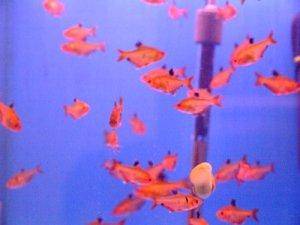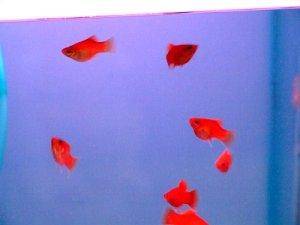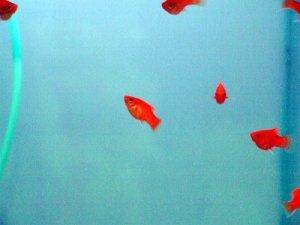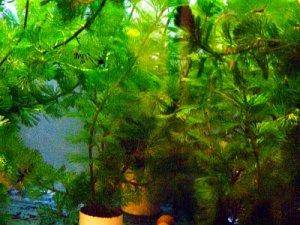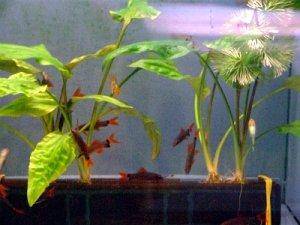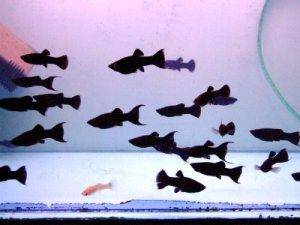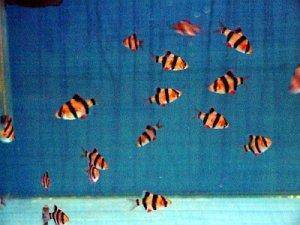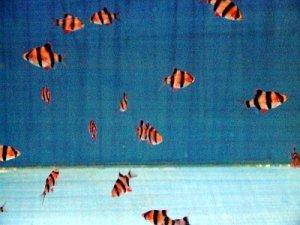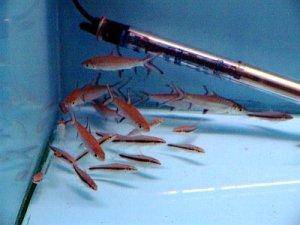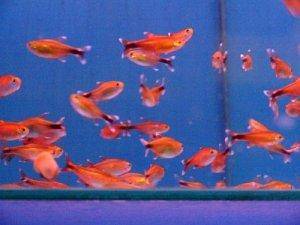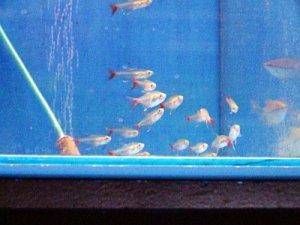A guide to the tropical fishkeeping
Quick links - Answers
Brief Description
This page is, as the title implies, about tropical fishkeeping and I wanted this guide to be easy to understand and easy to follow. You should also visit the following pages (will open in new window/tab): list of aquarium fish, list of aquarium plants and list of our articles. Once you've finished reading the guide below, the mentioned pages will give you a better insight on the fishkeeping hobby. Don't forget to share your experiences, problems and solutions regarding fish, plants and fish tanks, and submit your story at the bottom of this page. Questions are welcome too!
Before you start an aquarium, you should know many things about fish, plants, tanks, biotopes, lighting, filters and other details. Otherwise, your effort will result in diseases, unhappy fish and a dirty tank. Basically, it doesn’t matter if you want to start a species or community tank, it also doesn’t matter if you’re about to start a Cichlid tank or a tank with Guppies, Bettas, Gouramis or Catfish. There are very simple principles which apply to all tanks. Take aquariums very wisely and you’ll be happy with the result.
The right place and size for an aquarium
Before you buy anything, be sure you’ve chosen the right place for your future tank. The basic rules say that the place shouldn’t be very sunny or cold. Very good are the wall mounted aquariums, since they look nice and they also look like a natural part of the wall. Nowdays, the aquarium stands and backgrounds make it easy to create a beautiful scenery. Personally, I also like the corner aquariums very much; Rounded glass make them very attractive.
For the tropical freshwater aquariums, the temperature in the room shouldn’t be lower than 20°C (68°F) and higher than 30°C (86°F). It’s because you will spend a lot of money on the energy eaten by a heater or a chiller. Bear in mind, that the base under the tank must be as strong as needed. If you’re going to buy a 500 Liters (132 US Gallons) aquarium, you will probably need some iron stand, or simply install the tank on the floor. Some isolation would be great. Simply place some papers or polystyrene under the fish tank. It’s recommended because of two reasons:
- It will distribute the overall pressure equally, so no piece will be shirt-sleeved too much. If you don’t so, then it might lead to the glass disruption, which usually ends at the broken glass.
- It will help you to keep the temperature more stable. It’s a proven fact that some isolation layer is good for large tanks.
In order to select the right place, always think about accessibility. When you’ll feed the fish, you’ll need some access. More space is needed when you’re cleaning the tank. Don’t forget that you’ll install some aquarium lighting, heater, filter, so there will be a lot of cables. There is a simple solution how to hide these cables very easily. Let all electricity go to your aquarium equipment from the back. If you want a wall mounted tank, then it’s very simple. Some problems occur when you want the rectangular, hexagonal or a cylindrical aquarium. Generally, a piece of the aquarium should be hidden from an ordinary view, so you’ll be able to put all cables together.
As I said before, no direct sun beams should shine on your tank. Why?
- Direct sun makes the fish blind. They will not know where the top levels are. Imagine yourself as a fish; They consider that the sun beams come from the top levels, not from the right or left side.
- Direct sun might raise the temperature. This is dangerous during very warm months. Moreover, the algae loves the direct sun.
Anyway, direct sun isn’t very damaging if it shines only a few minutes during the days. Your fish will get unusual colours. Taking photographies is very easy, since you will not need any flash or special adjustment of the lights.
Pictures: Neon Tetra and Black Molly
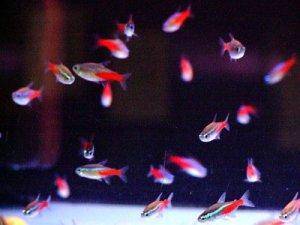
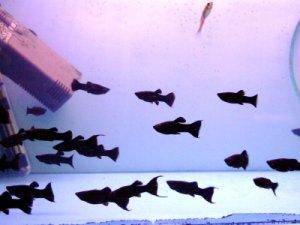
Selecting the right biotope
When you’ve finished with the place for your future tank, select the right biotope. This is very important point, since the success fully depends on it. Just imagine; You will want to buy some new fish or plants later, but they will be incompatible with the actual fish in your tank. Therefore, you should decide for all fish species before you buy them. Of course, it’s sometimes very attractive to buy new species, because they look pretty, but what if they eat other fish in your aquarium, or what if they’ll be eaten?
The basic "biotope" isn’t a real biotope. It’s somewhat a neutral; not hard, not very soft water with plants from different countries or continents and with fish which come from the entire world. Such tanks are called "community tanks" too. On the other hand, there are specialized tanks for built for cichlids, gouramis, discus fish and so on.
So which are the rules for your biotope? Firstly, make sure you are able to deliver the quality water to your tank. If you decided to keep cichlids, make sure the water will be alkaline and hard. If you want to keep the Discus fish, make sure the water will be very soft and a bit acidic. Your aquarium should copy the conditions like in the wild. Only if you make your fish happy, they will breed and live long.
Apart from the biotopes, you must know if you want the fish to breed in the future. For example, some fish need very special conditions for breeding. Many different species could eat the newborns. If you keep the Angel Fish, buy a male and a female only. Generally, more fish = more problems when breeding. The newborns are a kind of "live food", so fish don’t have to be a ravening one in order to eat the fry. My Guppies have eaten the Panda Cories’ eggs even though they’re fed enough. On the other hand, breeding isn’t sometimes worth it. Before you finally decide if to keep any fish for breeding, make sure:
1) There is someone who will buy your fish’ newborns. 2) The breeding process will not result in hundreds of newborns.
The chosen biotope should reflect every fish’ need including hiding, taking a rest, eating, breeding, swimming. If you’re not sure about the right biotope, try the tropical community aquarium. It’s also possible to place the tank to it’s place, set-up all equipment like filter or heater and then you’ll decide which biotope is the most suitable. If you like rocks, you’ll maybe like biotopes like African lakes. But what if you don’t like the cichlids? People think that they’re more aggressive than fish from Asia or America, but it’s a mistake. There are fish like the Jack Dempsey cichlid or the Jaguar Cichlid and they’re aggressive too.
The best thing what you could do, is to get some information about the fish which live in the biotope you’re going to set-up. Generally, every biotope consists of different plants, fish, water conditions even if they’re parts of one biotope. What I’m trying to say, is that you may keep very aggressive cichlids as well as peaceful ones too. The same goes to the fish from other countries or geographical location.
Pictures: Cichlids and Gold fish
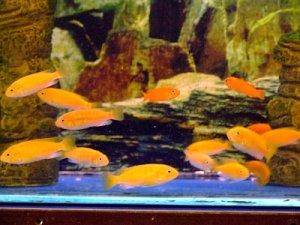
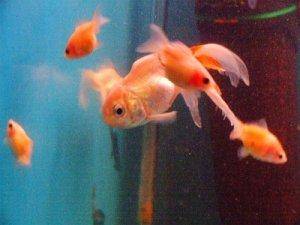
Installing and buying the equipment
Once you select the biotope, it’s time to buy and install the equipment. Filters, depending on the tank dimensions, is the most important of any tank. A filter carries two objectives: It should aerate the tank and it should filter the water, so the result is low water pollution. Fish excrements pollute the entire tank and if there is no filter, or the filter isn’t strong enough, it might lead to diseases and general problems including algae.
My tip is that it’s always better to install a strong filter. So if you have 100 Litres tank (22 US Gallons), install something what is designed for about 150 Litres (33 US Gallons). You’ll find it useful especially if you have a panoramatic aquarium. There’s nothing worse than a small filter which isn’t capable to filter enough. Personally, I use internal filters. They’re quite good and even I need to clean them once per 4-5 days, they’re of good quality.
The second thing when buying the equpiment for your tank is lighting. Fish and especially plants will need it and it’s up to you to choose for the best one. Generally, it’s recommended to buy purely the lighting designed for aquariums only. It’s because the plants need different light spectrum than people do. So it’s not very happy to buy any fluorescent lamp for this purpose. Nevertheless, fluorescent lamps generate enough heat for the entire tank. In this case, you won’t need any heater. You can buy various neon lights. Some of them give lilac to the fish, some of them shine sapphire. Neon lights save more energy than other types of lighting and their durability is something about 1 year.
Depending on the chosen biotope, you’ll need your lighting to shine about 10-12 hours each day. I found the automatic timer as the best solution. You never know when you get up or when you go to bed and even it seems easy, an automatic timer is very useful. It always turns on like you want. If you don’t need the filter or heater to be turned on all day long, you may attach them to another timer (or the same, it’s up to you). What’s more, you’ll save the energy. Feel free to use our aquarium calculator to help you with the calculations.
The heater is the third thing which we’re focusing on. Heating an aquarium could be useful in three cases:
1) The temperature in the room is very low 2) A fish is sick and you want to heal it 3) You want to breed the fish
Generally, heaters are energy eaters. If you have an aquarium of 400 Litres (106 US Gallons, 88 UK Gallons) , you’ll need a heater of about 490 Watts. Maybe 200 Watts heater could be enough, but if we use standard relations, you’ll need such power. It’s better to isolate the windows or the entire room. Anyway, heaters are required for fish treatment too. You’ll give more chances to fish to survive if you use a heater. Of course, you’ll need some medicament depending on the disease.
Another case when you should use the heater is fish breeding. Many fish will spawn only if the temperature is of about 28°C (82°F). We could talk a lot about breeding, so I’ll write more about this subject later in my another article. This part is dedicated to the equipment.
When you’re finished with the previous items, you should buy some substrate. A substrate is very important part of every aquarium. Without a proper substrate, it will be impossible to plant any plant and fish excrements will be very dangerous. The substrate should carry two main things:
1) Help filtration 2) Help the plants to reproduce
Whenever you watch the fish in the wild, you notice that there is some bottom level. All wastes go to the bottom where they decompose. Rivers, creeks or lakes in the nature don’t have any internal or external filter installed within. But the water is usually clear and full of fish. It’s because the bottom levels help the nitrification bacteria to decompose the wastes. Basically, it should be the same in your tank. Of course, it’s not possible to create such conditions from the beginning. You’ll have to change about 20% of water on a weekly basis until the substrate will contain enough bacteria in order to filtrate the water. The filter is very helpful and you shouldn’t use the substrate for natural filtration only.
Well planted plants look terrific and they help to filtrate the water too. Fish waste, what is poisonnous for fish, is welcome by plants. Enough waste and enough light create the right conditions for the plants to grow. So if you’re going to use the plastic plants only, bear in mind they will not decompose any waste. Basically, if the substrate is of good quality (granularity and height), it will help the plants to reproduce. Enough plants mean enough decomposition, enough hiding places for fish, enough oxygen and so on.
Plants usually don’t produce enough oxygen for all fish, so a filter which aerates the water is required in the most of cases.
For better feeling, it’s good to buy/create an aquarium stand. They’re usually made from wood or iron. Aquarium chillers are needed only in special cases and I described them in one of my previous articles as well as aquarium stands and other equipment.
The integral part of most aquariums should be some driftwood. Driftwood makes it easy for fish to hide, Plecos love them too. The only restriction is the size. Once you measure the dimensions, buy a driftwood of good quality. How will you know that it’s of good quality? Check if it’s completly dried and ask for the ancestry. A piece of wood in your tank will result in yellow or brown water, but it doesn’t mean that the water is of low quality. Driftwood helps to keep the conditions stable because of it’s chemistry. Before you put the driftwood into the tank, boil it in the salt water once or twice.
Pictures: Bala Shark and Angel fish
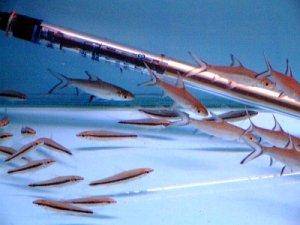
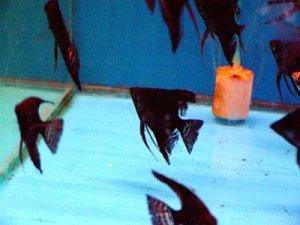
Buying and planting the plants
Mostly all aquarists start fishkeeping because of two basic reasons: They want to keep some beautiful fish and they want a nicely planted tank. What you won’t learn in the shops, is that you’ll need patience and a lot of time until your tank will look like you want in the beginning. Let’s divide all plants into the following groups:
By growth speed:
- Fast growing
- Normally growing
- Slowly growing
By light requirements:
- The plants with minimum light requirements
- The plants with medium light requirements
- The plants with maximum light requirements
We could go to another divisions, but it isn’t necessary. The divisions above will give you a perfect idea which plant to buy and how to ask about plants in the shops.
Basically, fast growing plants are good if your tank is very new. Slowly growing plants are usually the most beautiful (Anubias Nana and other). The second question goes to the plant’s aggressivity. Yes, even it sounds weird, some plants are very aggressive, since they will kill all other plants in the tank. They will simply grow everywhere and they will stop the light beams to other plants. Be careful when choosing the plants, because some expensive and nice plants may be killed by fast growing and aggressive ones.
Every aquarium plant needs some light to survive. Generally, I recommend you to buy the plants which don’t need extra lighting. Even if these plants look very beautiful (red colours), they’re sometimes taken from a garden, so they’re not purely freshwater and they will die after some time. If you’re an ordinary aquarist, you won’t need red coloured plants. An aquarium should house the happy fish with happy plants and not the colours from the entire world.
Planting the plants is sometimes very frustrating. You need very good substrate, otherwise you won’t be able to plant the plants. Of course, floating plants like Pistia don’t need any substrate. The substrate should keep all roots under the gravel (or sand or whatever you use as the substrate). Many plants reproduce themselves by roots or lateral shoots. So what’s needed is just some gravel. Put the roots into the gravel and backfill it. Bear in mind that if you backfill some higher parts of the plant, it won’t be bad. If there is any fish or a large snail in the tank, they could easily root any plant which isn’t planted properly.
Generally, you’ll need to plant the plants very wisely. Start with fast growing ones and place them to the background. Then, wait until they grow. You’ll probably buy some plants which reproduce themselves by cuttings. It isn’t anything bad, but you’ll need to cut them very oftenly. Apart from plants care, you’ll need to maintain your tank about once per week. Back to the cuttings; Usually, plants which reproduce themselves by cuttings, grow fast and are sometimes aggressive. It means you’ll need to control them, since they could occupy the entire tank.
Personally, I’d like to recomend you Vallisneria and Anubias species. They’re beautiful ones and taking care of them is very easy. However, Vallisneria needs more light than Anubias and once it grows well, you’ll need to control the reproduction process. Unlike Anubias, Vallisneria grows fast. Anubias species usually don’t need much light, but they are sensitive to the water chemistry changes. They’re also a bit expensive. I keep Cryptocoryne too. There is a very nice plant called Pistia, which is the floating plant. It likes acidic water more than the hard one, but generally does well under all conditions. People prefer it because of it’s unassuming requirements. One thing which will damage it, is very strong water current.. In this case, Pistia will die or it will grow to very small dimensions. Once all of your Pisitas are large, you could create strong water current, since it will not damage the large ones.
Once the background parts are planted well, continue with the middle parts of the aquarium. Basically, closer to the front, smaller plants are needed. You could divide the tank into the stages too. Lower the front parts, strengthen the construction by additional wood or larger rocks. If you’re going to keep any Catfish, I don’t recommend you to create the stages, since they will probably destroy them.
Pictures: Platy with Vallisneria and other plants
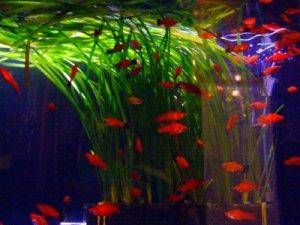
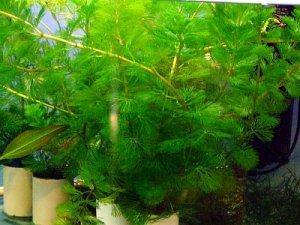
Creating the stable conditions
As I mentioned above, there are some basic tip show to keep the tank fine. Use as many natural tools as possible. Driftwood and rocks may help this process a lot. Why? Just because rocks contain minerals and wood does so. Basically, fish excrements are acidic and they could turn around the water chemistry.
Driftwood contains substances which invoke fish spawning naturally. Stable water chemistry is a way to happy fish and nicely looking aquarium. Crystal water isn’t the mark of stable conditions even if it looks nice. Generally, old aquarium means stable chemistry. If you care about the entire tank, you shouldn’t note any disease or chemistry changes.
Anyway, here are some factors which may lead to unfortunate causes:
- Dead fish
- Dead plants
- Too much ammonia and fish excrements
If there is any dead fish in the tank, you should remove it immediatelly. Otherwise, it will decompose and dead body is usually full of poisonous substances. Because of this reason, it’s good to keep various snails in a tank; They will eat everything dead. On the other hand, if a large fish dies, it isn’t possible to eat the whole body. Dead fish are another reason why to build a large aquarium, since a small fish won’t poison the whole tank and other fish will survive even if you don’t remove the dead one. Large aquariums usually use strong filters and their efficiency helps to keep the water without any dangerous chemicals or substances. But bear in mind, that dead fish should be always removed from the tank.
Dead plants are smaller problem than dead fish, but they could pollute the water too. Plants don’t produce any excrements, so they’re not as dangerous as fish are. Mostly, you can find dead plants at the surface, so simply collect them and swash them in the toilet.
Probably the most dangerous factor in any tank is too much fish excrements. Before the aquarium becomes stable with numerous bacteria collonies, it usually gets polluted. It’s because of missing balance during the first months. Here is one successfully tested method: Use a hose to remove the excrements. Never change the whole water. Fish will not like it and you’ll always start from the beginning. If you take enough care of your tank, you’ll probably find out that after a few weeks, no hose is needed, and that the excrements will be forged by the nitrification bacteria.
For better stability, use shells, rocks and, as I mentioned above, some driftwood. Rocks contain elements like calcium, shells do so. Sea shells are welcome, since they guarantee great balance. Basically, any excrement is acidic, sea shells are alkaline, so alkaline and acidic substances flatten. Be careful with any shell, because small fish may swim inside of them, but they won’t find a way back. The same goes to the rocks. Rocks should contain too much calcium only if you run a specialized tank for some kind of African cichlids. Place them the way they won’t fall down.
Pictures: Piranha and Tetra fish
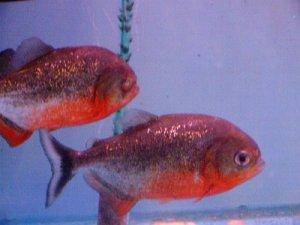
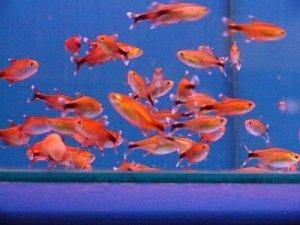
Choosing and buying the fish
Only if you’re finished with the previous steps, start buying fish. If you did everything like suggested, you won’t be sorry for buying incomatible species. Always think about the following criteria when going to the shop:
- Do I offer enough space to all the fish in my tank?
- Are my fish peaceful?
- Will they have enough space to swim, hide?
- Will they spawn? If yes, how oftenly?
- Is my aquarium large enough for adult size of any of my fish?
- Fish aren’t toys, they’re living animals and I must do my best for their happiness.
You should always know how large your new fish is going to grow. Never buy Angel fish if your tank’s height is lower than 30 cm (11.8 inches). Never buy 20 neon tetras if your tank’s capacity is lower than 20 litres (5.2 US Gallons and 4.3 UK Gallons). Never do anything what you’ll be sorry of. Always start with low number of fish and increase their number if it’s possible to do so. If you’re very new to aquariums, start with peaceful and modest fish like Guppies or Tetras. You’ll understand their behaviour and you’ll be ready for larger or a bit aggressive fish like Gouramis, Angel fish, Cichlids or so.
People also like to decide for a fish due to it’s colours. They like the black, deep blue and red colours the most. In my opinion, it’s a fatal mistake. „Such decisions“ usually end in the toilets.
Feel free to use our database in order to decide which fish to buy and which one to avoid.
Pictures: Various tetras
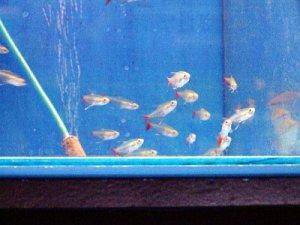

Feeding the fish
Feeding the fish depends on their needs. Some fish are active during the night hours, some fish are active through the days and so on. But probably each fish will enjoy the quality food. Flakes, granules, live food, frozen gnats, beef are delicacy for your pets. Change the food periodically, but care about vitamins too. I recommend you to use the flakes and granules as the primary food. Add frozen food or beef only in special ocasions. Otherwise, fish will be fat and unhealthy.
I feed my fish three times a day. Some time ago, I used to feed them only once per day, later I raised it to two meals each day until I decided to give them more food. Basically, more food equals more activity. Keeping the fish in captivity is sometimes stressful and food helps to eliminate these factors. Once you start feeding your fish three times a day, you’ll note more chases, little fights and more speed. On the other hand, more food leads to shorter life.
If the fish are fed well, they should be of natural colours and healthy. Don’t forget to remove old food which usually remains at the surface. Snails are good for this purpose, since they eat mostly everything. Some fish species eat the snails too. Apart from the live food, you should use carrot, potato, lettuce, and other vegetable. Vitamins are very important for proper growth and breeding. What’s more, you can eliminate the number of snails by carrot, since they love it. So simply put some carrot into the tank, wait a few minutes or hours (depending on the number of all snails in a tank) and start removing them.
I won’t recommend you to feed the fish with the amount which is eaten during 1 or 5 minutes, since the most food fall down to the bottom. Firstly, it’s necessary to feed them with the amount which they eat. Secondly, feed them slowly, so not all food will fall down to the substrate levels. Feeding is a bit funny, since you can look how the fish are fighting for food. Feeding gives you the opportunity to watch all fish if they’re not sick or if there is no missing one.
Pictures: Another beautiful species
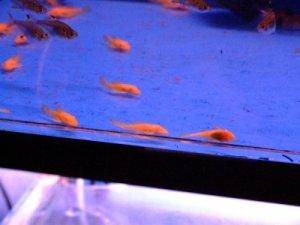
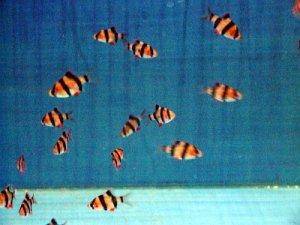
Cleaning and maintenance
As I mentioned above, the most part of cleaning an aquarium mostly equals to removing the fish excrements. Of course, there are some other activities included in the maintenance. Firstly, let me say that any equpiment might fail, or you’ll see that you need better filter, lighting, heater and so on.
For example, there are many filters on the market and they’re usually divided into some categories depending on their capatility to filter some amount of water. Then we’ll get the table saying the filter „A“ belongs to the first category, the filter „B“ is designed for larger aquariums and so. In my experience, such categorizing isn’t the best way how to decide what to buy. Some time ago, one plastic part on one of my filters broke and I wasn’t able to buy it. So I bought another filter. After 4 months, I got a new part of the old filter and I was wondering how powerful is it. What’s more, it aerates the tank much more.
Basically, you’ll need to test various parts and equipment until you get the desired effect. Your goal should be almost autonomus aquarium with minimal maintenance or cleaning.
Cleaning an aquarium includes removing algae, but „fighting the algae“ is the following part of this article, so I won’t explain the techniques here.
Pictures: Freshwater shark and Tetras
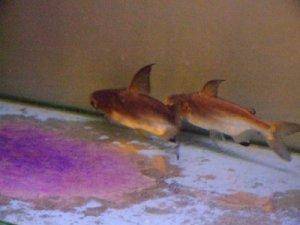
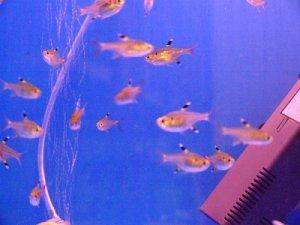
Fighting the algae
When everything’s done, fish are swimming, plants are producing oxygen and helping natural filtration, filter is filtrating, light is shining, heater is heating, you are a happy aquarist. Every coind has two sides and even if your tank is stable and beautiful, there is algae problem. Probably every aquarist has had this problem in his tank.
Let’s analyse the roots of the algae problem, so you’ll easily avoid it, or you’ll control algae in your tanks. Most of the cases when algae grows are the result of wrong lighting. Low or too much light could help the algae to grow. There are a few algae types, but all of them grow because of similar reasons.
The second thing which leads to algae growing is too much ammonia in the aquarium. Basically, take the algae as a small plant. A plant needs light, ammonia to grow. If there is not enough plants in the tank, algae will take it’s chance and it will grow.
Improper filtration is sometimes used as another reason of growing algae, the reason is that insufficient filtration results in a lot of ammonia in a fish tank.
So how to fight against algae? Firstly, use the proper lighting. Secondly, plant enough plants. Next, use strong filter which will help the nitrification bacteria. Another possibility is to buy fish which will eat the algae. Small plecos love algae like other Catfish do. When they’re adult, they will not care about algae at all.
You can remove the algae manually, but this will not solve the problem. Algae usually grow in the slow waters, so make sure there’s some water current in the whole aquarium.
Well, fighting the algae could be very frustrating especially when the algae wins, but I’d like to show you another point of view too. Algae isn’t anything bad if it grows at the bottom. It produces oxygen and it also decomposes the excrements. I’ve seen some aquariums with the gravel completly „planted“ by the algae and it wasn’t looking bad. So if you’re going to keep the Cichlids, you’ll find the algae very useful.
Additional photogallery

